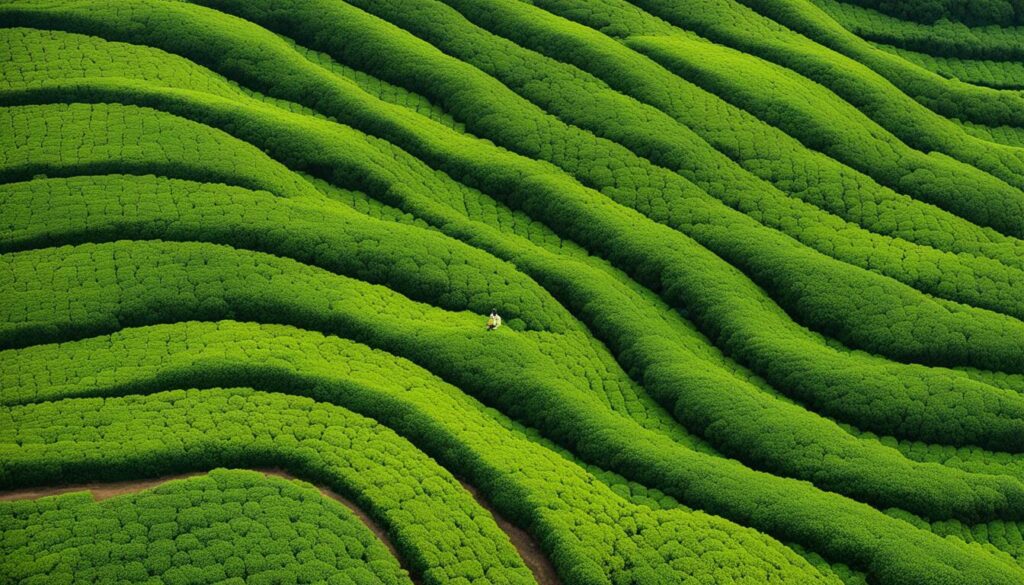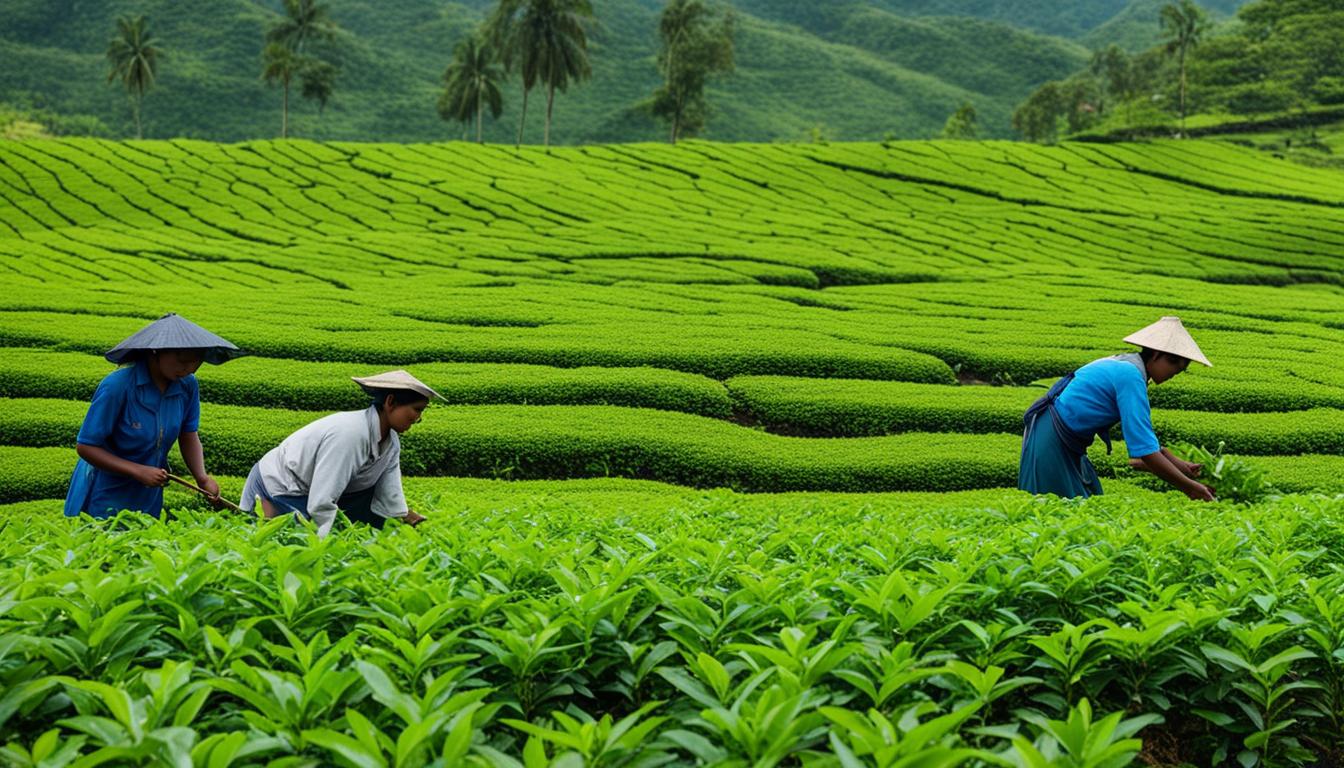Are you a tea enthusiast looking to maximize your tea garden yields? Well, you’ve landed in the right place! At [Your Company Name], we are passionate about helping tea farmers and enthusiasts alike unlock the full potential of their tea plants.
Tea is one of the most beloved beverages globally, with billions of cups enjoyed daily. But did you know that the yield of desired components in tea can be influenced by various factors? From fermentation to extraction, there are techniques that can optimize the yield of catechins, alkaloids, proteins, and carbohydrates in your tea.
With advanced technological advancements in green chemistry, we can assist you in minimizing deviations and retaining maximum quality in an environmentally-friendly way. Our review delves into the existing extraction processes, optimization parameters, decaffeination techniques, and large-scale cost-effective isolation of tea components using modern technology.
Whether you’re a farmer or a tea lover, this article will provide you with valuable insights into the techniques and approaches that can help you optimize your tea harvest yields. So, let’s dive right in!
Key Takeaways:
- Implementing advanced extraction processes can optimize the yield of desired components in tea.
- Optimizing parameters such as fermentation, extraction, and storage conditions is crucial for maximizing tea garden yields.
- Decaffeination processes and cost-effective isolation techniques are key considerations in tea production.
- Advanced technology, including tea cultivation yield management software, plays a vital role in enhancing productivity and efficiency.
- The prospects and limitations of these techniques allow for tailored extraction conditions based on specific needs.
Factors Affecting Tea Plant Yield: An Overview
Tea cultivation is a complex process influenced by various factors that can impact plant yield and quality. To maximize tea leaf quality and yield, it is essential to employ effective techniques such as tea garden fertilization, optimizing tea plant spacing, yield forecasting, and tea harvest yield analysis.
Tea Leaf Quality Improvement Techniques
One key aspect of tea cultivation is improving the quality of tea leaves. Proper fertilization is crucial in providing the necessary nutrients for tea plants to thrive. By using the right balance of organic and inorganic fertilizers, farmers can enhance tea garden yields and promote healthy growth.
Additionally, optimizing tea plant spacing can significantly impact yield. Adequate spacing allows for better light penetration, air circulation, and efficient harvesting. Farmers can strategically plan their tea garden layout to ensure optimal spacing and maximize tea plant yield.
Yield Forecasting in Tea Cultivation
Yield forecasting is an invaluable tool in tea cultivation. By accurately predicting tea harvest yields, farmers can plan and manage their resources effectively, ensuring optimal production and minimizing waste. Factors such as weather conditions, soil health, and previous harvest data are considered to forecast tea yield accurately.
Tea Harvest Yield Analysis
Analyzing tea harvest yields provides valuable insights into the factors that affect productivity. By closely examining factors such as weather patterns, pruning techniques, and pest management strategies, farmers can identify areas for improvement and implement necessary adjustments to optimize yield.
| Factors Affecting Tea Plant Yield | Techniques for Improvement |
|---|---|
| Tea garden fertilization | Proper nutrient balance through organic and inorganic fertilizers |
| Tea plant spacing | Optimal spacing for better light penetration, air circulation, and harvesting efficiency |
| Yield forecasting | Accurate prediction of tea harvest yields for effective resource management |
| Tea harvest yield analysis | Thorough examination of factors affecting productivity for targeted improvements |
By implementing tea leaf quality improvement techniques, utilizing yield forecasting, and analyzing tea harvest yields, farmers can optimize their tea cultivation practices and achieve higher yields while maintaining the quality of their tea leaves.

Pruning and Microclimate Optimization in Tea Gardens
Pruning is a crucial technique for improving tea yield and quality. By selectively removing dead or diseased branches and stimulating new growth, pruning helps maintain the plant’s shape and overall health. It plays a significant role in enhancing tea yield by allowing the plant to allocate more resources to productive branches and leaves. Through proper pruning techniques and regular maintenance, tea farmers can maximize their yield and ensure the longevity of their tea garden.
Optimizing the microclimate in tea gardens is equally important for achieving optimal tea yield. The microclimate refers to the specific environmental conditions within a tea garden, including factors such as shade, temperature, and humidity. Creating an ideal microclimate can help tea plants thrive and produce high-quality leaves. Shade management techniques, such as strategically positioning taller plants or using shade cloth, can regulate temperature and prevent excessive sunlight exposure. Proper ventilation and irrigation techniques also contribute to optimizing the microclimate and ensuring the well-being of the tea plants.
The Benefits of Pruning in Tea Gardens
Pruning offers several benefits beyond increasing tea yield. It promotes overall plant health by improving air circulation and reducing the risk of disease. Pruned tea plants also tend to have stronger, more resilient branches, which can withstand harsh weather conditions. Additionally, pruning allows tea farmers to shape the plants according to their desired aesthetics, creating visually appealing tea gardens.
Optimizing the Microclimate for Tea Growth
The microclimate in tea gardens significantly influences tea plant growth and yield. By carefully managing shade, temperature, and humidity, tea farmers can create an environment that promotes optimal growth and productivity. Shade management techniques, such as using shade cloth or strategically planting taller trees, help regulate sunlight exposure and minimize leaf scorching. Proper ventilation and irrigation ensure that tea plants receive adequate air circulation and water, preventing water stress and promoting healthy growth.
| Benefits of Pruning: | Optimizing the Microclimate: |
|---|---|
| • Increased tea yield | • Regulates shade |
| • Improved overall plant health | • Maintains optimal temperature |
| • Stronger, resilient branches | • Controls humidity levels |
| • Enhanced aesthetics of tea gardens | • Promotes healthy growth |
The Role of Technology in Tea Cultivation Yield Management
Technology plays a crucial role in helping tea farmers optimize their cultivation practices and maximize yield. One of the key tools that farmers can utilize is tea cultivation yield management software. This software provides real-time data and analysis, allowing farmers to understand and monitor various aspects of their tea production.
With tea cultivation yield management software, farmers can track and manage important factors such as irrigation, fertilization, and pest control. The software provides insights and recommendations based on data analysis, enabling farmers to make informed decisions and adjustments to improve yield and quality.
This advanced technology also helps tea farmers streamline their operations and resource management. By utilizing the software’s features, farmers can efficiently allocate resources, plan harvest schedules, and optimize their cultivation practices. This not only enhances productivity but also reduces costs and minimizes waste.
Benefits of Tea Cultivation Yield Management Software
There are several benefits of using tea cultivation yield management software:
- Real-time monitoring: Farmers can access real-time data on their tea cultivation parameters, allowing them to spot and address any issues promptly.
- Optimized resource management: The software provides recommendations for efficient resource allocation, ensuring that tea plants receive the necessary nutrients, water, and care.
- Improved decision-making: Data analysis and insights from the software help farmers make informed decisions to optimize their cultivation practices and improve yield.
- Increased productivity: By leveraging technology, farmers can enhance productivity, leading to higher tea yields and improved profitability.
Overall, tea cultivation yield management software is a valuable tool that empowers tea farmers with the knowledge and resources to optimize their cultivation practices and achieve higher yields and quality. By embracing technology, tea farmers can stay ahead in an increasingly competitive market and ensure the sustainability and success of their tea gardens.

Conclusion
Throughout this article, we have explored various techniques and factors that contribute to optimizing tea harvest yields. From advanced extraction processes to proper tea plant spacing and microclimate optimization, there are numerous strategies available to tea farmers seeking to enhance yield and quality.
One tool that has proven invaluable in modern tea cultivation practices is tea cultivation yield management software. This software provides farmers with real-time data and analysis, allowing them to make informed decisions and maximize productivity. By leveraging the power of technology, farmers can streamline processes such as irrigation, fertilization, and pest control, ultimately leading to improved yield and quality.
While yield optimization techniques and technology play significant roles in tea cultivation, it is important to consider the unique needs and conditions of each tea garden. By tailoring these strategies to specific requirements, farmers can unlock the full potential of their tea crops. With continuous innovation and implementation of these advanced techniques, we can further elevate the art and science of tea cultivation, ensuring a bountiful and sustainable supply of this beloved beverage.
FAQ
What are some techniques for optimizing tea harvest yields?
Some techniques for optimizing tea harvest yields include implementing advanced extraction processes, employing proper tea plant spacing, and optimizing the microclimate in tea gardens.
How does fertilization impact tea garden yields?
Fertilization plays a vital role in enhancing tea garden yields by providing the necessary nutrients for plant growth.
Why is tea plant spacing important?
Optimizing tea plant spacing allows for better light penetration, air circulation, and efficient harvesting, resulting in improved tea yield.
How can yield forecasting in tea cultivation be beneficial?
Yield forecasting in tea cultivation helps farmers plan and manage their resources effectively, leading to better productivity and quality.
What is the importance of pruning in tea cultivation?
Pruning is essential for maintaining the shape of the tea plant, removing dead or diseased branches, and stimulating new growth, which can result in increased tea yield.
How does optimizing the microclimate in tea gardens contribute to yield improvement?
Factors such as shade, temperature, and humidity can significantly impact tea plant growth and yield. Creating an optimal microclimate through shade management, proper ventilation, and irrigation techniques can enhance tea yield and ensure optimal plant health.
How can technology aid in tea cultivation yield management?
Technology, such as tea cultivation yield management software, can assist farmers in monitoring and optimizing various aspects of their tea production, resulting in improved efficiency and productivity.





